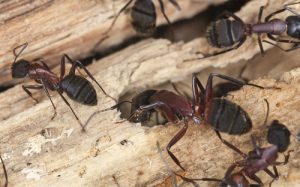Carpenter Ants a “Versatile Nest Builder”
By Chris Williams on May 4, 2011.
The Carpenter ant is a ‘versatile pest’ According to the Webster’s New World dictionary, versatile means competent in many things, adaptable to many functions… You get the idea. This ant is very flexible when it comes to nest sites in and around the home. How many nests could you have around your home and where might they be located? Well, it depends. You may have a single colony (established by a ‘founding queen’) or a mature main colony with several satellite colonies. Okay, so what exactly does it all mean, single colony, main colony, or satellite colony? Carpenter ant males and females swarm periodically during warm spring days. Mating takes place during the swarm and then females (queens) remove their wings and settle in a moist secluded area. This could be in a rotting fence post, tree stump, soil beneath stones, or any undisturbed objects outside or in damp areas inside the home such as underneath insulation in basements which is very common.
 Over the course of several seasons, this ‘single colony’ can grow into one containing a few thousand workers, and may begin producing reproductive individuals (kings and queens) capable of starting new colonies. Next, a ‘main’ colony may be located in a standing live tree. The neighborhood where I live is quite old and there are several ‘street’ trees that are at least one hundred to one hundred fifty years old. These trees support huge colonies of carpenter ants. The swarming carpenter ants I see outdoors every spring are most likely coming from the giant silver maple across the street from my house and from other old trees nearby.
Over the course of several seasons, this ‘single colony’ can grow into one containing a few thousand workers, and may begin producing reproductive individuals (kings and queens) capable of starting new colonies. Next, a ‘main’ colony may be located in a standing live tree. The neighborhood where I live is quite old and there are several ‘street’ trees that are at least one hundred to one hundred fifty years old. These trees support huge colonies of carpenter ants. The swarming carpenter ants I see outdoors every spring are most likely coming from the giant silver maple across the street from my house and from other old trees nearby.
Why do carpenter ants produce ‘satellite colonies’ and how could one or more of these become established in your home? Let’s use the big maple tree across the street from my home to set the stage for one scenario. Although my neighbors and the utility company do an excellent job at maintaining this old tree, suppose a severe thunderstorm with high winds breaks off a major limb this summer. Carpenter ant workers that were tending to business in this tree limb are now ‘exposed’ to the elements, (weather, predators, etc.) and chances are very good that they could invade either my place or my neighbor’s house. Lets’ also suppose that I’m the lucky one, and within a few weeks time I start noticing Carpenter ants crawling along the sills in my basement. I peel back some insulation and discover two to three hundred ants along with a cache of pupa both large and small that the ants have carried in. Now all ants have a complete lifecycle, and this pupal stage is a transitional phase between the larva and adult stage. The large pupa in the scenario I describe here represent future winged reproductive ants.
My little make believe story is not at all far fetched, because every year we receive calls from homeowners that experience invasions of carpenter ants. Oftentimes it may be because a new house lot is being cleared nearby or maybe a neighbor has recently had new landscaping installed. These disruptions of habitat cause colonies to break apart and flee and they’ll seek out new shelter wherever they can, like perhaps your attic or basement.